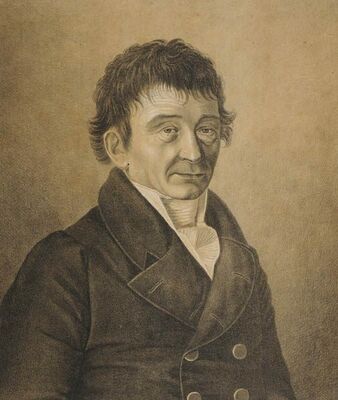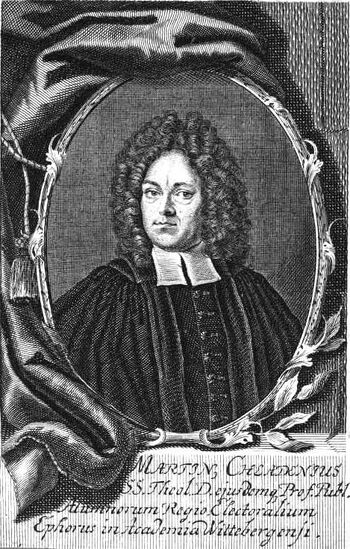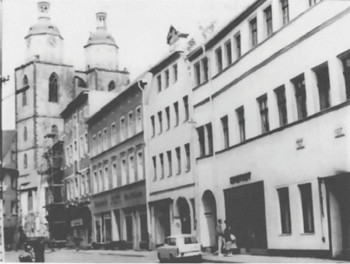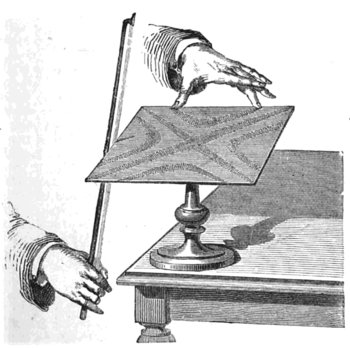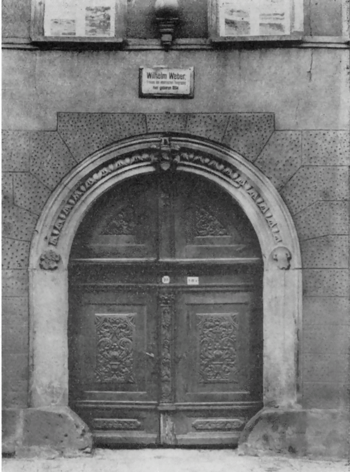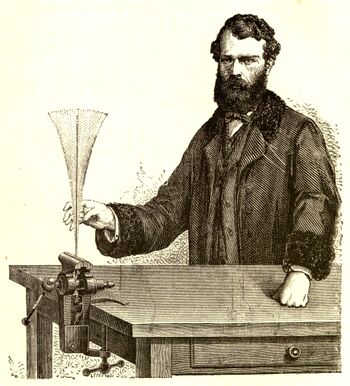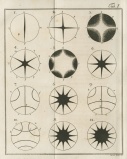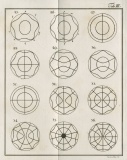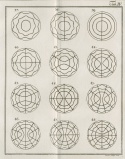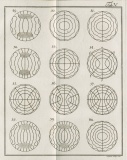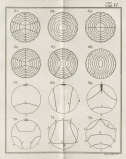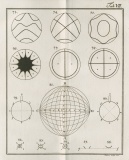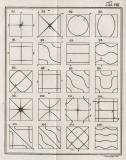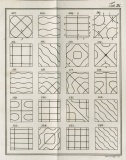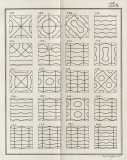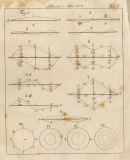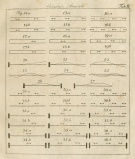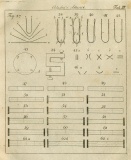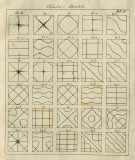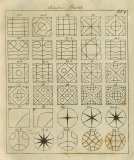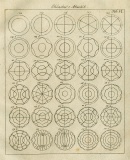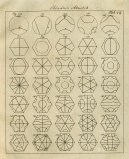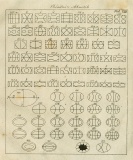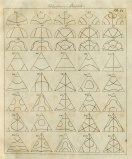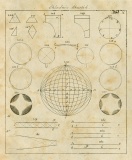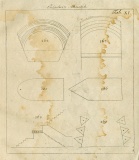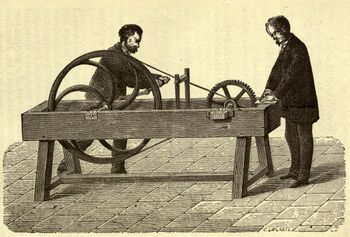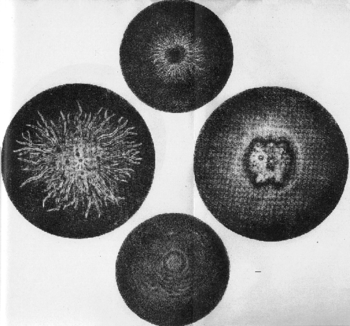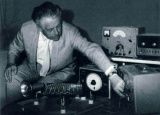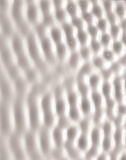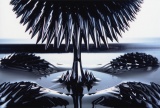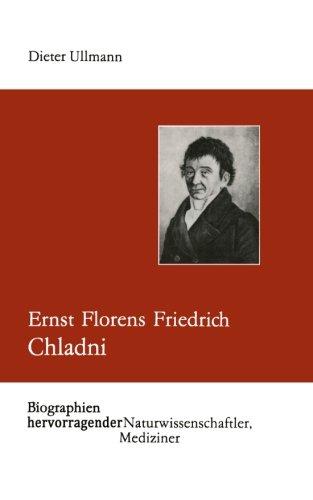Ernst Chladni
Ernst Florens Friedrich Chladni was a physicist and musician. His work includes research on vibrating plates and the calculation of the speed of sound for different gases. For this some call him the "father of acoustics". He also did pioneering work in the study of meteorites, and therefore is regarded by some as the "father of meteoritics" as well.
He was a corresponding member of the Academy of Sciences in St. Petersburg (1794), Royal Society of Harlem in the Netherlands, Royal Society of Natural Scientists in Berlin, Society of the Arts and Sciences in Mainz, Academy of the Applied Arts in Erfurt, Philomatic Society of Paris, Batavia Society in Rotterdam, and societies in Munich and Göttingen.[12]
Contents
- 1 Life
- 2 Work
- 3 Notes
- 4 Bibliography
- 5 Links
Life[edit]
Ancestors[edit]
Chladni came from an educated family of academics and learned men. Chladni's great-grandfather, Georg Chladni (Chladenius, 1637–92), studied at gymnasium in Banská Bystrica (Neusohl) and theology at a university in the Protestant city of Wittenberg. He served as head of a protestant school in Špania Dolina (Herrengrund) near Banská Bystrica (1666), and from 1667 as a protestant rector of a church in Kremnické Bane (Johannesberg) 4 km away from Kremnica (Kremnitz), a mining town in the Kingdom of Hungary (today central Slovakia). After shortly living in Görlitz, Upper Lusatia, he returned to Kremnica. But after criticising Jesuits and Catholic church from his position of a Lutheran theologian, during the Counter Reformation he had to flee the town (on 19 October 1673), along with his wife and 4-year old son, Martin. From 1680 he worked as a rector of a church in Hanswald where he died.[1][2]
Chladni's grandfather, Martin Chladni (Chladen, Chladenius, Chladenio, 25.10.1669–12.9.1725, born in Kremnica [13]), was also a Lutheran theologian. He studied philosophy and theology in Wittenberg (1688), and received litentiate in theology in 1704. He served in Dresden, Ubigau (1695), Jassen; in 1710 became professor of theology at the University of Wittenberg; in 1719 provost; and in 1720–21 was dean of the faculty of theology and later rector of the university. He authored around 70 religious scripts and dissertations, in Latin and German. He had one son, Ernst. Died in Wittenberg.[3]
Chladni's uncle, Justus Georg Chladni (Chladenius, 1701–65), was a law professor at University of Wittenberg. Another uncle, Johann Martin Chladni (1710–59), was a theologian and historian, and professor at the University of Erlangen and the University of Leipzig.
Parents[edit]
Ernst Florens Friedrich Chladenius was born in 1756 in Wittenberg, Electorate of Saxony (today Germany). As a consequence of the Reformation in the 16th century, Wittenberg had become the cultural centre of Europe due to the work of Martin Luther and Philipp Melanchthon, and the University Leucorea of Wittenberg was considered the most important north of the Alps. In the 18th century, however, Wittenberg had meanwhile degraded to the status of a provincial town in Saxony, and the university as well had lost its great renown.[4][5]
His father, Ernst Martin Chladni (Chladenius, 6.8.1715–4.3.1782 [14]), was first professor of law (1746), and ten times dean of the law faculty of the University of Wittenberg. He published almost 50 works, and was also a court counselor in Saxony and antiques expert.[6][7]
His mother was Johanna Sophia (born Clement, 10.5.1735–6.3.1761, married in 1753), daughter of a High Court notary (Hofgerichtsprotonotar) and later lawyer at the Consistory of Wittenberg, Johann Gottlieb Clement (9.11.1692–24.12.1759, born in Großbothen(?) near Leipzig, died in Wittenberg), and his wife Anna Sophia, a daughter of Johann Christoph Wichmannshausen.[15]
After death of his mother, his father remarried Elisabeth Johanna Charlotte (born Greipziger, 1725–21.4.1801), widow of privy councilor of the Duke of Württemberg and Lord of Genthe, Meinecke.[8][16]
Early years[edit]
Ernst Florens Friedrich's sister passed away when she was a baby and he grew up as the only child. Chladni received home education; his father had very strict, even despotic way of upbringing. Ernst Friedrich could only leave his study room after his permission; couldn't go even to their garden other than accompanied by his mother; and was not allowed to have any friends. At the age of 7 he was already reading scientific books, studied stars and maps, secretly learning Dutch, and dreamt about becoming a seafarer.[9][10][11]
Studies[edit]
From May 1771 to March 1774 he visited the boarding-school [Landesschule] of St. Augustinus at Grimma near Leipzig. These Landesschulen had been established in secularized monasteries after the reformation, and served as colleges of the Saxonian state for the future government officials, teachers and Protestant preachers. The severe education at home continued in Grimma. Chladni was not allowed to stay at a hostel like the other pupils, but had to live in the flat of one of his teachers, and therefore was again under permanent supervision. His father disapproved of his interest in medicine and insisted that Ernst Friedrich become a lawyer.[12][13][14]
From 1776, Chladni studied law and philosophy (as well as mathematical and physical geography, physics, biology, and geometry) at the University of Leipzig, and obtained a philosophy degree in 1781 and law degree in 1782. Around that time he changed his surname from Chladenius to Chladni. During his studies he joined a masonic lodge of Leipzig, Minerva zu den drei Palmen[17]. Upon his return to Wittenberg, his father arranged a lawyer position for him.[15]
Scientific career[edit]
- Lecturing in Wittenberg (1783–92)
After the death of his father in 1782, Chladni's life changed fundamentally. He felt responsible for his stepmother, which was the main motivation to stay in Wittenberg, although his financial situation was difficult. At the University of Wittenberg one of the two professors in mathematics passed away in 1784, and Chladni applied for the vacant position. But the position was cancelled, and he had to abandon his hopes. In 1783–92 he gave lectures, first on legal subjects, from 1784 on geometry and mathematical geography, and from 1786 in his real field of research, acoustics.[16][17]
- Early experiments in acoustics (from 1782)
He moved to acoustics as a relatively underexplored scientific field at the time.[18] In 1782 he started with extensive experiments in his flat. Chladni wrote: "For a long time it was my main activity to analyse such sound sources, which had not yet been studied. Up to now only vibrations of strings and vibrations of air in wind instruments were the subjects of studies. And now I performed experiments on transversal vibrations of rods, which had been the subject of theoretical studies of Leonhard Euler and Daniel Bernouilli, and then on the vibrations of plates, which were an unknown field."[19][20][21]
- Exploration of sound figures (from 1785)
First Chladni investigated transversal vibrations of rods with different boundary conditions. The violin bow was the instrument for the mechanical excitation. The idea for this came from a publication on the glass harmonica by the Bach biographer Nicolaus Forkel. This source intimately influenced Chladni's work on instrument making. The essential idea to the sound patterns came from the study of the works by Georg Christoph Lichtenberg. In 1777 Lichtenberg succeeded in making spark discharges in dielectrics visible by decorating the objects with sulphur and minium powders (see below). This motivated Chladni to apply fine sand to his plates and rods. With this method of sound patterns he could confirm the formulas for the characteristic frequencies of rods, which had been derived theoretically. Chladni had a sensitive ear. He could discriminate frequencies differing by less than a semitone. With experiments with vibrating plates with flexural rigidity - the two-dimensional counterpart to rods - Chladni opened a field, which had hardly been studied neither theoretically nor experimentally. Existing theories by Euler and Michael Golovin had been in contradiction to Chladni's experiments.[22]
Chladni studied systematically the sound patterns of circular, square, and rectangular plates, by fixing them with his fingers at different points, thus enforcing at these points the occurence of nodal lines. The results were published in 1787 in Entdeckungen über die Theorie des Klanges with 11 plates and a total of 166 figures. At the end of this book Chladni reminded of the unsolved problem of the mathematical treatment of flexural vibrations of plates.[23]
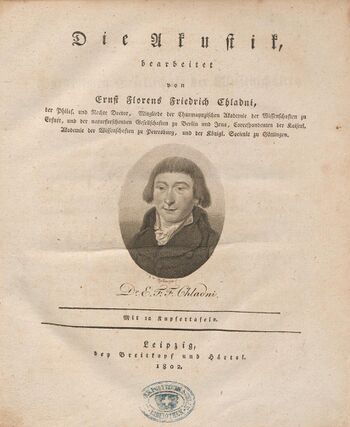
- Lecture tours (from 1791)
From 1791, after his invention of sound figures and building his music instrument (Euphon, see below), also motivated by lack of money, throughout his life he was doing lecture/performance/exhibition tours, usually lasting several months, to present his work around Europe, each time returning for a short period to Wittenberg. In 1792 he sold his home in Mittelstrasse 5 (but lived in this house until the death of his stepmother in 1801). The first travel led him first to Dresden, then to Berlin. Originally he meant primarily to perform music using his instruments, but noticed that his sound figures attracted much more acclaim and made it central to his presentations. Chladni's demonstrations in many royal academies and scientific institutions frequently drew large crowds who were duly impressed with the aesthetically sophisticated qualities of vibrating plates. He quickly came to be known as a "traveling scientist", and used the visits of various cities to acquire new contacts among scientists but also to study various materials on acoustics in its libraries and archives. He visited Germany (Dresden, 1791, c1797; Berlin, Jan–Feb 1792, Dec 1798–Mar 1799, 1826–Feb 1827; Göttingen, Dec 1792–Jan 1793; Bremen, Feb 1793; Hamburg, Mar–Apr 1793; Erfurt, Aug 1795; Weimar, 1803; Munich, c1798, 1812), Denmark (Copenhagen, Apr 1793, 1797; Flensburg, 1794), Prussia (Danzig, 1794; Königsberg, 1794; Breslau, Feb–Apr 1827), Russia (Riga, 1794; Petersburg, May 1794; Tallinn, 1794), Austria/Bohemia (Prague, c1797; Vienna, c1798, 1812; Karlsbad, 1812), Netherlands (Amsterdam, Dec 1807), Belgium (Brussels, c1808), France (Paris, Dec 1808–Mar 1810; Strasbourg, 1810), Switzerland (Basel, May 1810; Zürich, 1810), Italy (Turin, October 1810–Apr 1811; Milan, Apr–May 1811; Bologna, 1811; Florence, May 1811; Venice, 1811), among other places. Between 1802–12 he visited half Europe. In 1815 he started a new period of journeys, and in lectures included his theory of meteors.[24][25][26][27]
- Contact with Lichtenberg (from 1792) and Kempelen
In December 1792–January 1793, Chladni visited Göttingen, where he met and befriended Lichtenberg. This contact was the beginning of Chladni's interest in meteors and later his theory of their extraterrestric origin.[28][29] Lichtenberg was often visited by Wolfgang von Kempelen who had built a chess automaton to make fun of the scientists from around Viennese Court and was conducting a serious research of acoustics (he built a speaking machine, 1769–1804 [18]; published the book Mechanismus der menschlichen Sprache, 1791). He organised a meeting where Kempelen presented his speaking machine to Chladni, who later tested and discussed Kempelen's hypotheses in his books Beiträge zur praktischen Akustik und zur Lehre vom Instrumentenbau (1821) and Über die Hervorbringung der menschlichen Sprachlaute (1824).[30]
- New home (1801)
In 1801 he moved from his family house to the Zur Goldenen Kugel [To the Golden Ball] house on Schlossstrasse 10. In this house the future physicist Wilhelm Weber was born 1804.[31]
- Die Akustik (1802)
In 1802 he published his breakthrough work Die Akustik which soon acquired a status of foundational work of a new scientific field and him a title of "father of acoustics". It was the first systematic description of the vibrations of elastic bodies. The arrangement of the book in chapters on (i) sound generation, (ii) sound propagation, and (iii) sound reception was new, too. In the book he compiled, commented and built upon numerous articles on acoustics found on his travels across Europe.
- An encounter with Goethe (1803)
On the occasion of a visit to Weimar, in January 1803 Chladni met Goethe to whom he gave a copy of his book. About their first encounter, Goethe wrote the following in a letter to Schiller: "Doctor Chladni has arrived and has brought his complete Acoustics in a quarto volume. I have already read half of it and shall give you a somewhat agreeable oral report on its content, substance, method, and form. He belongs to [..] those blissful persons who have not the faintest idea that there is something as Naturphilosophy and who are only attentively trying to observe phenomena which they will then classify and make use of them as well as their natural talent is capable in the matter and is trained for the matter." They met again in Goethe's home in June 1812. A few years later, however, Goethe has made several positive statements on Chladni's behalf in public.[32][33]
- Paris (1808–10), meeting Napoleon and translation of Die Akustik (both 1809)

During his stay in Paris in December 1808 Chladni presented his work at the French Academy of Sciences which organised the evaluation commission consisting of physicists Étienne de Lacepède, Prony, Hauy, and music scientists Mehul, Gretry, and Gossec. His study was met with very positive feedback and Pierre-Simon Laplace, together with Gay-Lussac, Alexander von Humboldt and Arago, proposed him to translate it to French. Napoleon was also interested in a demonstration of Chladni's experiments and invited him to the Tuilerie Palace through the mediation of Laplace. While performing artists were rather often invited to court, the invitation of a scientist was a singularity. In February 1809, Chladni presented Napoleon (also present were Laplace, La Cépède, Berthollet) his sound figures, mathematical foundations of acoustics and performed a composition by Haydn on his Clavicylinder, and the following day received a 6,000-franc grant to translate his work to French. In doing so, he encountered a problem. For the German terms Schall, Klang and Ton, used by Chladni with different meanings, the French language only knows one concept, namely son, e.g. sound. A Frenchman he asked about this matter gave him the following answer: "Notre diablesse de langue ne veut pas se prêter à l'expression de toutes les idées possibles. Il faut même quelquefois sacrifier une idée aux caprices de la langue." [Our devil of a language does not want to lend itself to the expression of all ideas possible. Sometimes it is even necessary to sacrifice an idea to the caprices of the language." Chladni seized this opportunity to a thorough modification, he eliminated the out-of-date and added new ideas. The French edition was eventually published in November 1809, with dedication to Napoleon (which caused him trouble after Napoleon became enemy of the rest of Europe). Chladni left Paris in March 1810.[34][35][36][37]
- Move to Kemberg (1813)
In the summer of 1813, Chladni suffered a great loss. The remnants of Napoleon's army were entangled in numerous fights and skirmishes in Saxony after the retreat from Moscow, returning to France. Wittenberg was besieged by the Prussians, so Chladni was compelled to move to a dwelling with a single room in the small town of Kemberg, situated 15 km to the south of his home town (where he was visited in 1821 by Felix Mendelssohn-Bartholdy[38] among others). In the autumn of the same year the flat he left in Wittenberg burnt out, flared up by a fire rocket which had hit the neighbouring house. Chladni deplored the loss of many objects dear to him, including excerpts and notes on experiments. He had been, however, lucky to have rescued most of his belongings, among them the Euphon and the Clavicylinder. A single room served him as bedroom, workshop, and drawing room at the same time. He spent the rest of his life in Kemberg, only interrupted by the still numerous lecture tours.[39][40]
- Optics
In Munich, Chladni met Joseph von Fraunhofer, a physicist who sparked his interest in optics.[41]
- Room acoustics
In Die Akustik, a book with 310 pages, room acoustics took up only 7 pages, reflecting the state of the knowledge in 1802. At the beginning of the 19th century room acoustics was treated in geometrical terms. The importance of resonances had been recognized, and it was known that the ear can distinguish at most 9 different sound impulses per second. But on sound absorption and related questions there was a lot of obscurity.[42]
During a stay in Berlin in 1825 Chladni met the architect Carl Theodor Ottmer, who showed him his drafts for the new building of the Singakademie in Berlin (today Maxim Gorki Theatre). The Singakademie was a choir conducted by Carl Friedrich Zelter and devoted itself to the performance of works by Johann Sebastian Bach, and the building became one of the best music halls in Germany until its devastation in 1943.[43]
- Weber brothers
Chladni's students, brothers Ernst Heinrich and Wilhelm Eduard Weber, took upon Chladni's research of acoustics and solved many of his outlined questions[19][20][21][22][23]. Resulting book, Wellenlehre, auf Experimente gegründet (1825)[24], is dedicated to Chladni. He tested their findings both in theory and experiment and did not find any errors.[44] (W. E. Weber, together with Carl Friedrich Gauss, went on to construct the first electromagnetic telegraph in 1833 [25].)
Inspired by the acoustic research of the Weber brothers, Chladni resumed his work from Die Akustik, but the resulting book Kurze Übersicht der Schall- und Klanglehre (1827) did not reach level of its famous forerunner.[45]
- Languages and art
Through reading fiction Chladni kept himself fluent in Greek, Latin, Dutch, French, English, and Italian, and also spoke oriental languages and dialects. He had a habit of reading non-German literature in its original language. Thanks to his extensive travels he also had a strong knowledge of painting and sculpture.[46]
- Death
In February 1827 Chladni went from Berlin to Breslau where he gave lectures. He passed away in the night of 3 to 4 April. The evening before his death he met the mineralogist Henrik Steffens who reported on this meeting in his memoirs[47]. Chladni was born in the same year as Mozart, and died in the same year as Beethoven. He lived a nomad life from his mid-30s and according to his own words never received an acceptable offer of a professorship (despite the offers for positions in Berlin, Jena, and Dresden in the late 1810s).[48] Chladni never married and had no kids. In his will, he bequeathed his collection of 41 meteors[49] to the Berlin Mineralogy Museum, 5000 Thaler to his tenant farmer [Hauswirth], 600 to the poor, and 600 to the city of Kemberg for a new tower clock and paving.[50] The site of his grave had been forgotten.
He gave a detailed survey of his life in the introduction to the French edition of Akustik (1809) as well as in his Neue Beyträge (1817).
Legacy[edit]
Goethe, who himself was often criticized for his diverse study of natural sciences, wrote in 1817: "Who will criticize our Chladni, the proud of the nation? The world owes to him gratitude, since he made the sound visible. And what is more distant from this subject than the study of the meteorites? Not at all, but that an ingenious man feels the impetus to study two natural phenomena which are far away from each other, and investigates both of them continuously. Let us be grateful for the benefit we gained from it!"[51]
A small lunar impact crater that lies near the northwest edge of Sinus Medii, in the central part of the Moon, is named after Chladni[26], as well as asteroid no. 5053.
In Doktor Faustus (1947), Thomas Mann based the character of the father of the hero of the novel, Adrian Leverkühn, on Chladni. He gets introduced in its introductory chapter. This father likes to "speculate", e.g. "to labour on nature, to stimulate phenomena to tempt it by exposing its work through experiments." These experiments are rather peculiar. There are drops moving like amoebae and eating up each other. There are structures grown in saline solutions suggesting to be mosses or algae. And there are sounds appearing in the form of geometrical patterns. All these phenomena and experimenting anyway in the poet's eyes are the work of the "tempter".[52]
Work[edit]
Rejection of the monochord[edit]
In 1787, Chladni explained, on the basis of his sound patterns, how various sounds coexist in the vibration of the same body. But this simultaneous presence of com-possible sounds, he said, cannot be reduced, in a Pythagorean way, to the overtones of a fundamental: there are also "inharmonic and irrational relationships", due to the irregularities of the vibrating body.[27] This is why Chladni dismisses the monochord, the instrument that was the basis of acoustic theory and calculation since Greek antiquity; as Chladni writes in the introduction to his Akustik: "a string is only one sort of sonorous body," among many others. This dismissal of the Pythagorean monochord and calculation is Chladni’s revolution, his modernity. It opens the possibility of experimenting with all vibrating bodies, while his sound patterns allow us to see their complex vibrating structure.[53]
The debate over the vibrating string was part of the gradual divorce of acoustics from music that took place in the 18th century. Music, as one of the four sciences of the medieval quadrivium, was traditionally part of mathematics. The tradition still held in the 18th century to some extent. The beginning of acoustics as a branch of physics is often dated from Chladni's Entdeckungen (1787), but throughout the century natural philosophers raised questions about the production and propagation of sound that were not properly part of harmonics.[54]
Tonometer[edit]
The problem of Chladni's time was that it was not possible to determine frequency of particular tone (pitch) of the sound body (string, rod, membrane) since its vibrations were too fast to be followed and counted by the eye. Based on Mersenne’s laws of vibrating strings (1636/37) – the number of vibrations of a string is inversely proportional to the length of the string, and, proportional to the square root of its tension (which were further improved by Joseph Sauveur[28]) – Chladni constructed a tonometer (1800). The idea was to attach one end of the rod long enough to count its vibrations on its other end (e.g. 4 per second). By shortening it to its half the tone and frequency would increase four times (square of 2). Chladni would shorten the rod until its tone would correspond to the tone of the string whose frequency he was looking for.[29][55] Chladni constructed a tonometer made of bars, whose rates of vibration was determined as above. With this he hoped to be able to determine the rate of vibration of any sonorous body whatever. However the results given by experiment only approximate those demanded by theory.[30]
Chladni figures (Klangfiguren)[edit]


One of Chladni's best-known achievements was inventing a technique to show the various modes of vibration of a rigid surface. First published in 1787 in his book Entdeckungen über die Theorie des Klanges, the technique consists of drawing a bow over a (circular, square, or rectangular) plate or membrane whose surface is lightly covered with sand. When stroked, a given plate will resonate at one of its natural frequencies. The sand bounces about on the plate until settling at nodal points (areas of zero movement) thereby producing intricate patterns. These patterns are now called Chladni figures.[31]
The phenomenon was earlier mentioned by Leonardo da Vinci in his notebook, and as well discussed by Galileo Galilei. He noticed that small pieces of bristle laid on the sounding-board of a musical instrument, were violently agitated on some parts of the surface, while on other parts they did not appear to move, and wrote about it in his work Dialogo sopra i due massimi sistemi del mondo [Dialogue Concerning the Two Chief World Systems] (1632). Later, Robert Hooke of Oxford University proposed to observe the vibrations of a bell by strewing flour upon it (c1680).[32]
Chladni did not mention the experiments of Galilei and Hooke in his own writings. Regardless of whether he was aware of them or not, he was the first to examine the phenomenon systematically. His original inspiration were the electrical figures of Lichtenberg, who made the experiment of scattering an electrified powder over an electrified resin cake; the arrangement of the powder revealing the electric condition of the surface[33]. In 1785, Chladni set out to explore this phenomenon from the perspective of acoustics.[56] He explained in a biographical preface to the French edition of Die Akustik (1809):
"As an admirer of music, the elements of which I had begun to learn rather late, that is, in my nineteenth year, I noticed that the science of acoustics was more neglected than most other portions of physics. This excited in me the desire to make good the defect, and by new discovery to render some service to this part of science. In 1785 I had observed that a plate of glass or metal gave different sounds when it was struck at different places, but I could nowhere find any information regarding the corresponding modes of vibration. At this time there appeared in the journals some notices of an instrument made in Italy by the Abbé Mazzocchi, consisting of bells, to which one or two violin bows were applied. This suggested to me the idea of employing a violin bow to examine the vibrations of different sonorous bodies. When I applied the bow to a round plate of glass fixed at its middle it gave different sounds, which, compared with each other, were (as regards the number of their vibrations) equal to the squares of 2, 3, 4, 5, &c.; but the nature of the motions to which these sounds corresponded, and the means of producing each of them at will, were yet unknown to me. The experiments on the electric figures formed on a plate of resin, discovered and published by Lichtenberg, in the memoirs of the Royal Society of Göttingen, made me presume that the different vibratory motions of a sonorous plate might also present different appearances, if a little sand or some other similar substance were spread on the surface. On employing this means, the first figure that presented itself to my eyes upon the circular plate already mentioned, resembled a star with ten or twelve rays, and the very acute sound, in the series alluded to, was that which agreed with the square of the number of diametral lines."[34][35]
- Birth of modern acoustics
‘Acoustics’ was an experimental investigative enterprise in the early 19th century. The group of so-called ‘acousticians’ included Chladni, Young, Félix Savart, Colladon, Faraday, Charles Wheatstone, Lissajous, Tyndall, Koenig, A. Mayer, etc. Their experimental works were summarized in John Tyndall's Sound (1867)[36]. In addition to ‘acousticians’, there were researchers who did research theoretically on the making and transmitting of sound in the mathematical manner. This group included Bernoulli, Jean LeRond d'Alembert, Euler, Joseph Louis Lagrange, Poisson, Sophie Germain, G. Ohm, Kirchhoff, Riemann, Donkin, S. Earnshaw, etc. For them analysis was the central method of dealing with problems associated with sound. Their investigations were not closely connected to the empirical and experimental findings gathered by the ‘acousticians’.[37](p 2765)
Further developments in acoustics[edit]
The influence of Chladni's Traité d'acoustique (1809) on the scientific research in France shows up in the work by Félix Savart, who was the direct successor of Chladni in France in the field of experimental acoustics. With a gearwheel siren with a diameter of 82 cm and 720 teeth built by Savart a precise measurement of the frequency of tones became possible. Savart measured the upper limit of audibility and found the high value of 24,000 Hz.[57]
In Germany, Hermann von Helmholtz wrote his Die Lehre von den Tonempfindungen 60 years later.
An unsolved problem in Chladni's days was the tone quality, the timbre. For a long time it was known that a sound of the same pitch, produced with different musical instruments, has different qualities. Chladni assumed the coexistence of weak noises (schwache Geräusche) with each sound, being responsible for the different tone qualities. Georg Simon Ohm solved the problem in 1843. He found that in the human ear a Fourier harmonic analysis of the tone takes place. In addition the ratio of intensities of harmonic fundamentals is important, whereas phase differences between the harmonics are irrelevant. Harmonics had been a research field in acoustics, which was underestimated strongly by Chladni.[58]
Mathematical solutions of Chladni figures[edit]
In his Akustik, Chladni didn't offer mathematical explanation of his figures and neither of other acoustic phenomena.
- Sophie Germain
After Chladni's audience to Napoleon in 1808, he encouraged the Paris Academy of Sciences to announce a prize of 3,000 Francs for mathematical explanation of Chladni figures, particularly "to give the mathematical theory of the vibration of an elastic surface and to compare the theory to experimental evidence", which then spurred a plethora of research in waves and acoustics. The award was given in 1816 to the mathematician Sophie Germain for her work Recherches sur la théorie des surfaces élastiques[59],[38][60]. Her explanation was incomplete (she found the correct differential equation, but the hypothesis she applied for the derivation of this equation was partly incorrect leading to the wrong boundary conditions), but she received the prize all the same since it was acknowledged that her treatise signified an essential progress.[61]
- Charles Wheatstone's approximation by cosine and sine functions
Charles Wheatstone had tried in 1833[62] to approximate Chladni figures using sine and cosine functions.[63] He showed that in square and rectangular plates every figure, however complicated, was the resultant of two or more sets of isochronous parallel vibrations; and by means of simple geometrical relations he carried out the principle of the ‘superposition of small motions’ without the aid of any profound mathematical analysis, and succeeded in predicting the curves that given modes of vibration should produce.[39]
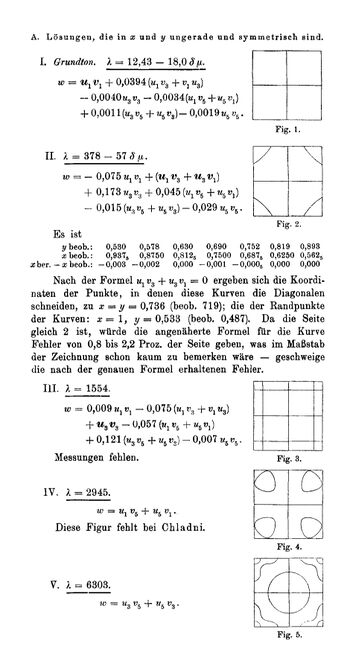
- G. Kirchhoff's solution for circular plate
Kirchhoff came up with the correct mathematical model in 1850[64], treating Chladni figures on a square plate as eigenpairs (eigenvalues and corresponding eigenfunctions) of a biharmonic operator. He also managed to solve the Chladni problem for the special case of a circular plate, which, due to symmetry, is much easier to handle. For other configurations, the partial differential eigenvalue problem with the free boundary conditions simply proved to be too difficult to solve.[65]
- W. Voigt's solution for rectangular plate with two or four clamped boundaries by elementary integration
In the case of clamped boundaries, the problem greatly simplifies, and W. Voigt found the general solution in 1893[66] for a rectangular plate with two or four clamped boundaries by elementary integration. Toward the end of the 19th century, the great expert in sound, John William Strutt, later Baron Rayleigh, summarized the situation in (1894): "The problem of a rectangular plate, whose edges are free, is one of great difficulty, and has for the most part resisted attack"[40][67].[68]
- Walter Ritz's solution
In his groundbreaking paper (1909)[69], Walter Ritz presented a method for computing Chladni figures: instead of trying to solve the partial differential eigenvalue problem directly (and neither through boundary conditions of the problem), he proposed to use the principle of energy minimization (Prinzip der kleinsten Wirkung), from which even those equations and conditions could be derived.[70]
Chladni figures of irregularly shaped plates have experienced a surprising topicality nowadays. The reason is the equivalence between the stationary wave equation, the Helmholtz equation, and the stationary Schrödinger equation for a particle moving freely in a box with reflecting walls. This enables the examination of such quantum billiards, and, in the case of irregularly formed walls, of the quantum chaos by means of vibrating plates[41]. Nodal patterns are also of central importance in totally different domains, in fields of light[42], in earthquake damage pattern[43], and even in pattern formation in the visual cortex[44].[71]
Chladni figures in Naturphilosophy[edit]
The very fact that Chladni's work with the sound figures was triggered by Lichtenberg's electrostatic figures for which he was trying to find an acoustic analogue, coincided with a naturphilosophische search for symmetries and signs of hidden relationships among natural forces.[72]
According to the most general version of this romantic theory, manifest for example in the writings of Herder, all of nature speaks through its form, and the physiognomy of the natural world is cast as language, the "book of nature" that merely awaits correct deciphering. A more restricted variant holds that only those aspects of nature which have a formal feature reminiscent of inscription are to be described as hieroglyphs. Here nature seems to be saying something in a language that the human race can no longer understand, that it has forgotten. But this language is in fact the most ordinary language, the Ur-alphabet in which creation was, as it were, spelled out. Indeed, unlike all subsequent languages, what marks this primordial language is that it does not require any code at all since, here, sign and referent are the same. These hieroglyphs are what they mean. Their unintelligibility today is simply an index of the extent to which the present era has lost touch with that nature. For the German romantics, there were generally only two ways to reestablish contact with this Ur-language: either through the direct, but ephemeral, recreation of that language through poetry, or the more tedious, step-by-step relearning of that alphabet through the scientific exploration of nature. The task of physics was thus to make legible once again the currently unintelligible hieroglyphs of nature. Indeed, for the romantics, the discoveries of contemporary physics seemed to confirm the promising visions of the poets.[73]
Through this reading, Lichtenberg's figures (1777) made the then mysterious phenomenon of electricity finally become readable. With Chladni figures (1787), for the first time, one could associate acoustic phenomena to specific graphic figures which, most importantly, were "drawn" by the sounds themselves. These were not arbitrary but were rather in some sort of a "necessary" - indexical - relation to the sounds.[74]
- Ørsted
This very problem was explored in 1806, when the prominent Naturphilosoph Hans Christian Ørsted--who would become famous for his discovery of electromagnetism in 1820--used Chladni's technique (using alcohol and lycopodion powder instead of sand) in a further effort to disclose a connection between sound and electricity.[75]
- Ritter (via Benjamin)
Both Lichtenberg's and Chladni's figures intrigued another romantic physicist, Johann Wilhelm Ritter. In them, Ritter saw nature's own form of script-Ur-images and hieroglyphs that constituted the true alphabet of the Book of Nature. He wrote in 1810[76]:
"It would be beautiful if what became externally clear here were also exactly what the sound pattern is for us inwardly: a light pattern, fire-writing. [..] Every sound would then have its own letter directly to hand [..] That inward connection of word and script - so powerful that we write when we speak [..] has long interested me. Tell me: how do we transform the thought, the idea, into the wqord; and do we ever have a thought or an idea without its hieroglyph, its letter, its script? Truly, it is so: but we do not usually think of it. But once, when human nature was more powerful, it really was more extensively thought about; and this is proved by the existence of word and script. Their original, and absolute, simultaneity was rooted in the fact that the organ of speech itself writes in order to speak. The letter alone speaks, or rather: word and script are, at source, one, and neither is possible without the other [..] Every sound pattern is an electric pattern, and every electric pattern is a sound pattern. [..] My aim [..] was therefore to re-discover, or else to find the primeval or natural script by means of electricity. [..] In reality the whole of creation is language, and so is literally created by the word, the created and creating word itself [..] But the letter is inextricably bound up with this word both in general and in particular. [..] All the plastic arts: architecture, sculpture, painting, etc. belong pre-eminently among such script, and developments and derivations of it."[45], quoted in Walter Benjamin[77].
Ritter held the opinion that material images, like Chladni figures, entailed the true language--a pictorial language--of science. He reveled in the pure multiformity of the Klangfiguren, their symmetry, and their relationship to other forms in nature. While the mathematical approach to sound was by no means excised, it was this respect for the image and the attitude that pictures could give meaningful signs of phenomena that excited the Naturphilosophen.[78]
- Young
The natural philosopher, Rosetta stone sleuth, and undulatory optical theorist Thomas Young embraced the pictorial approach to the study of sound. In 1800, Young introduced a new technique for obtaining a visual image of the motion of a vibrating string, while referring to Chladni figures. He also pioneered a means for creating permanent inscriptions of sonic vibrations (1807). In the 19th century, Wilhelm Weber and Guillaume Wertheim, as well as many other investigators, devised related ways to preserve the traces of styluses attached to sounding bodies, such as rods and tuning forks.[79]
- Purkyně
The research of Chladni figures in the 1810s–20s by the physiologist Jan Evangelista Purkyně, which he later discussed with Goethe, is also notable. For more, see the article on Purkyně's work.
Chladni figures in modern aesthetics[edit]
Towards the end of the 19th century, the identification of recording instruments and graphs with language became less obvious, but the association was not entirely lost. German philosophers such as Friedrich Nietzsche, Walter Benjamin[80] and Theodor Adorno carried the pursuit of graphical "ur-languages" from Chladni and Ritter into the aesthetics of recorded music.
- Nietzsche
Nietzsche had referred to the sound figures in his On Truth and Falsity in Their Ultramoral Sense (1873)[46][47]:[81]
"One can imagine a man who is quite deaf and has never had a sensation of tone and of music; just as this man will possibly marvel at Chladni's sound figures in the sand, will discover their cause in the vibrations of the string, and will then proclaim that now he knows what man calls 'tone'; even so does it happen to us all with language. When we talk about trees, colours, snow and flowers, we believe we know something about the things themselves, and yet we only possess metaphors of the things, and these metaphors do not in the least correspond to the original essentials."[48]
- Adorno
Adorno in his essay "The Form of the Phonograph Record" (1934) saw in Chladni's sound figures a kind of primal gramophony.[82] For him, the mechanical reproduction of music reversed the process of turning signs (the musical score) into music and instead turned music into language:[83]
"This occurs at the price of its immediacy, yet with the hope that, once fixed in this way, it will some day become readable as the 'last remaining universal language since the construction of the tower', a language whose determined yet encrypted expressions are contained in each of its 'phrases'. If, however, notes were still the mere signs for music, then, through the curves of the needle on the phonograph record, music approaches decisively its true character as writing. Decisively, because this writing can be recognized as true language to the extent that it relinquishes its being as mere signs: inseparably committed to the sound that inhabits this and no other acoustic groove. If the productive force of music has expired in the phonograph records, if the latter have not produced a form through their technology, they instead transform the most recent sound of old feelings into an archaic text of knowledge to come. [..] A good part of this is due to physics, at least to Chladni's sound figures, to which--according to the discovery of one of the most important contemporary aesthetic theorists [here Adorno means Walter Benjamin]--Johann Wilhelm Ritter referred as the script-like Ur-images of sound."[84]
For Adorno, the phonograph record had the advantage over the musical score in that it had written on it a language, not "mere signs". The machine avoided the trap of semiosis--the "mechanical" assignment of mere signs to music--and preserved its aesthetic value in a new language. He attributed the source of this argument to Chladni and Ritter, who first saw the possibility of "inscribing music without it ever having sounded".[85] In its reification of both sound and time, for Adorno, the phonograph record recalled Chladni figures in another sense as well: where music writes itself there is no writing subject. The record eliminates the subject (and the concomitant economy of intentionality) from the musical inscription.[86]
Cymatics[edit]

The physician and anthroposophist Hans Jenny (1904-1972) extended Chladni's explorations (also inspired by systems theory), conducting rigorous experiments with liquids and using oscillators to precisely calibrate audio signals. Jenny delved deeply into the many types of periodic phenomena, but especially into the visual representation of sound. He pioneered the use of lab-grown piezoelectric crystals, which were quite expensive at the time. When connected to amplifiers and frequency generators, the crystals acted as transducers, converting frequencies into vibrations strong enough to cause the plates to resonate. Jenny used a variety of materials for the plates, including glass, copper, wood, steel, cardboard, and ceramics, on which he sprinkled fine powdered lycopodium spores from a club moss and quartz sand. He also conducted a series of experiments with liquid glycerin in water and light refracted in a single drop of water containing fine particles that reflect the light source, in a series of experiments that produced his most famous images (see cover of his book). Much of this work is documented in still photographs compiled in two volumes of Kymatik, published in 1967 and 1974, and reissued as a single edition in 2001[87]. He later speculated about the potential healing powers of certain sound frequencies, a notion that has been presented as fact by some of his followers.
Chladni figures in the arts[edit]
Alvin Lucier's piece The Queen of the South (1972) is using Chladni figures (Lucier is said to be influenced by Jenny's book on cymatics).[49]
Jenny's work was also followed up by Center for Advanced Visual Studies (CAVS) founder György Kepes at MIT. His work Flame Orchard included an acoustically vibrated piece of sheet metal in which small holes had been drilled in a grid. Small flames of gas burned through these holes and thermodynamic patterns were made visible by this setup.
Photographer, philosopher and Cymatic researcher, Alexander Lauterwasser has used finely crafted crystal oscillators to resonate steel plates covered with fine sand and also to vibrate small samples of water in Petri dishes. His first book, Water Sound Images (2006), features imagery of light reflecting off of the surface of water set into motion by sound sources ranging from pure sine waves, to music by Ludwig van Beethoven, Karlheinz Stockhausen, electroacoustic group Kymatik (who often record in surround sound ambisonics), and overtone singing.[50] (Video), (Video).
Carsten Nicolai's Milch (Milk) (2000) reveals how sound frequencies ranging from 10 to 150 Hz, almost imperceptible to the ear, alter patterns of disturbances they caused in milk.[51]
In Protrude, Flow (2001) by Sachiko Kodama and Minako Takeno, sounds in the exhibition space, including those of the audience, interactively transform three-dimensional patterns in black magnetic fluid, which appears to be choreographed to its sonic environment.[52](Video).
Carsten Nicolai, Milch, 2000. At 50 Hz. [1]
Sachiko Kodama and Minako Takeno, Protrude, Flow, 2001.[2]
Instrument design[edit]
Variations of this technique are still commonly used in the design and construction of acoustic instruments such as violins, guitars, and cellos. Since the 20th century it has become more common to place a loudspeaker driven by an electronic signal generator over or under the plate to achieve a more accurate adjustable frequency.
Music instruments[edit]
Since at least 1738, a musical instrument called a Glassspiel or Verillon created by filling 18 beer glasses with varying amounts of water was popular in Europe. The beer glasses would be struck by wooden mallets shaped like spoons to produce "church and other solemn music". Benjamin Franklin was sufficiently impressed by a verillon performance on a visit to London in 1757 that he created his own instrument, the "armonica" in 1761.
Franklin's armonica inspired several other instruments, including two created by Chladni. In 1790, Chladni invented the musical instrument called Euphon (e.g. beautiful sound; not to be confused with the brass instrument euphonium) composed of glass rods and steel bars made to sound through rubbing with moistened fingers. Chladni also improved on the Hooke's "musical cylinder" (or "string phone", of 1672) to produce another instrument, the Clavicylinder (1799)[53], which however did not get as popular as Franklin's armonica at all.
Chladni described his Clavicylinder in the following way:
"The Clavi-cylinder contains a set of keys, and behind them a glass cylinder, seven centimeters (about three inches) in diameter, which is turned by means of a pedal, and loaded wheel. This cylinder is not the sounding body, but it produces the sound by friction on the interior mechanism. The sounds may be prolonged at pleasure, with all the gradations of crescendo, and diminuendo, in proportion as the pressure on the keys is increased or diminished. This instrument- is never out of tune. It contains four octaves and an half, from ut, the lowest in the harpsichord, up to fa."[54]
Meteorites[edit]
In 1794, Chladni published Über den Ursprung der von Pallas gefundenen, in which he proposed that meteorites have an extraterrestrial origin. This was a controversial statement at the time, since meteorites were thought to be of volcanic origin. With this book Chladni also became one of the founders of modern meteorite research.
Chladni was initially ridiculed for his claims of an outer space origin for meteorites, but the important minds of his period agreed with this view, including Lichtenberg and Humboldt, and his writings sparked scientific curiosity that eventually led more researchers to support his theory. In 1795 a large stony meteorite (c28 kg) was observed during its fall to earth at a cottage outside of Wold Newton, Yorkshire, England. A piece of this ordinary chondrite, known as the Wold Cottage meteorite, was provided to British chemist Edward Howard who, along with French mineralogist Jacques de Bournon, carefully analyzed the elemental composition of the meteorite and concluded that an extraterrestrial origin was likely. In 1803 a meteor shower over L'Aigle, France peppered the town with over 3000 fragments of meteorites with hundreds of witnesses to the stones falling. The L'Aigle meteor shower was investigated by French physicist and astronomer Jean Baptiste Biot, under commission of the French Minister of the Interior. Unlike Chladni's book and the scientific publication by Howard and de Bournon, Biot's article was a popular and lively report on meteorites that convinced a number of people of the veracity of Chladni's initial insights.
Discovery of longitudinal vibrations[edit]
When the bow had an acute angle to the string, Chladni heard notes which were 3 to 5 octaves higher than the usual tones. At first he examined the phenomenon with strings and then with rods from different materials. Thus Chladni discovered longitudinal vibrations (or dilatational vibrations) of bodies. In 1796 he gave a lecture in Erfurt at the Kurfürstlich Mainzische Akademie nützlicher Wissenschaften and presented first results of his experiments on this subject. Chladni now distinguished between transversal and longitudinal vibrations as it is usual today.[88]
Looking into Chladni's last book from 1827, one notes a confusion of notation on this subject in papers of other authors. Chladni found that the frequencies are reciprocal to the length of the string or the rod. If the diameter or the tension of the string is changed there are only negligible variations of the frequency for the longitudinal vibrations. Chladni had difficulties to find the dependence of the frequency on the density of the material. When Chladni investigated cylindrical rods, he discovered their torsional vibrations. In the first publication in 1796 and 1797 on this topic one gets the impression that he classifies this type of vibrations as a third class of vibrations in addition to the transversal and longitudinal ones. But in the later publications he argues against this possible misunderstanding and denotes these vibrations a special form of transversal vibrations.[89]
Weber brothers in 1825 had an idea, how to make longitudinal vibrations visible. They used glass tubes, and distributed dry sand in the interior of the tubes. The tube was hold horizontally and excited to longitudinal vibrations by rubbing the tube. The grains of sand started to move and formed little piles. This method was further developed by August Kundt in 1866 to the well-known method of dust figures.[90]
Measuring the speed of sound in solids and gases[edit]
Chladni must have noticed quickly that the technique of longitudinal vibrations can be used to measure the sound velocity in sound bodies. To this end he applied an indirect method. At that time only the velocity of sound in air was known (by work of Pierre Gassendi, begun in 1635). Chladni was assuming that the longitudinal vibrations of air in cylindrical form (e.g. in an organ pipe) are analogous to the longitudinal vibrations of a rod. Rods of a material which is examined will be fixed in the centre, e.g., for the fundamental vibration the length of the rod is half the wavelength of the tone. This tone is now compared with the fundamental vibration of an organ pipe with the same length, it shows the same vibrational state. With the velocity of sound in air, Chladni could measure the velocity of sound in several solids (tin, silver, copper, glass, iron, several kinds of woods). He published the results in 1797.[91][55][92]
In 1798 Chladni visited the chemist and botanist Franz von Jacquin in Vienna, and in his laboratory he did experiments to determine the velocity of sound in gases. In Wittenberg Chladni lacked the necessary equipment to carry out difficult scientific experiments, therefore he often used the devices of other scientists when visiting them on his journeys. To determine the velocity of sound of gases Chladni used the same idea he applied earlier for solids. He compared the tone of an organ pipe in a special gas with the tone of this pipe in air. Thus he obtained the speed of sound in oxygen, nitrogen, carbon dioxide, nitrogen oxide and hydrogen.[93]
Vibrations of tuning forks[edit]
Musicians had used tuning forks since their invention in 1711 by John Shore, but they were not considered worthy of attention by scientists until the work of Ernst Chladni, who was the first to systematically investigate their vibrations.[56][57][58].
Chladni found that a tuning fork in its fundamental oscillation may be looked upon as the flexural vibration of a rod with two nodal points. If this rod is bent to a fork, the nodal points in the middle approach each other. If the tuning fork is struck with a mallet, the higher eigenvibrations, being unharmonious to the fundamental vibration, are excited only weakly and decay very quickly. In 1826 Chladni published further studies on the tuning fork. Rotating a tuning fork about 360 degrees he noticed four maxima and minima of intensity. If the forks vibrate out of phase, he argued, the teeth periodically approach each other and depart from each other. In the latter case the air experiences a velocity in outward direction. At the same time the spacing between the teeth is extended, and the air moves to the inside. Between these regions there must be directions, where the air has the velocity zero. After a half-period all velocities change their signs, with an analogous change in the emission pattern.[94]
Chladni's law[edit]
In Die Akustik (1802) Chladni observed that the addition of one nodal circle raised the frequency of a circular plate by about the same amount as adding two nodal diameters, a relationship that Rayleigh (1894) called Chladni's law.[59]
Notes[edit]
- ↑ RumanovskýStadtrucker 1961, pp. 13–14
- ↑ Mešterová 2006, p. 127
- ↑ Mešterová 2006, pp. 127–128
- ↑ Ullmann 2007, pp. 25–26
- ↑ Stöckmann 2007, p. 15
- ↑ RumanovskýStadtrucker 1961, pp. 14–15
- ↑ Mešterová 2006, p. 128
- ↑ RumanovskýStadtrucker 1961, p. 20
- ↑ RumanovskýStadtrucker 1961, pp. 14–16
- ↑ Mešterová 2006, p. 128
- ↑ Stöckmann 2007, pp. 15–16
- ↑ RumanovskýStadtrucker 1961, pp. 18–19
- ↑ Ullmann 2007, p. 26
- ↑ Stöckmann 2007, p. 16
- ↑ RumanovskýStadtrucker 1961, pp. 18–19
- ↑ RumanovskýStadtrucker 1961, p. 21
- ↑ Ullmann 2007, p. 27
- ↑ RumanovskýStadtrucker 1961, p. 22
- ↑ RumanovskýStadtrucker 1961, p. 24
- ↑ Ullmann 1996, p. 14
- ↑ Ullmann 2007, p. 27
- ↑ Ullmann 2007, p. 27
- ↑ Ullmann 2007, p. 27
- ↑ RumanovskýStadtrucker 1961, pp. 28–29
- ↑ Ullmann 2007, pp. 28–30
- ↑ Ullmann 1996, pp. 47–51
- ↑ Ullmann 1996, pp. 117–121
- ↑ Ullmann 1996, p. 53
- ↑ Ullmann 2007, p. 28
- ↑ RumanovskýStadtrucker 1961, pp. 34–37
- ↑ Ullmann 2007, p. 28
- ↑ Stöckmann 2007, pp. 18–19
- ↑ Ullmann 1996, pp. 115–116
- ↑ Melde 1866, pp. 14–16
- ↑ RumanovskýStadtrucker 1961, pp. 43–49
- ↑ Stöckmann 2007
- ↑ Ullmann 2007, p. 30
- ↑ Heise 2007, p. 3
- ↑ Melde 1866, p. 18
- ↑ Stöckmann 2007, p. 21
- ↑ Ullmann 2007, p. 30
- ↑ Ullmann 2007, p. 30
- ↑ Ullmann 2007, pp. 30–31
- ↑ RumanovskýStadtrucker 1961, pp. 51–52
- ↑ RumanovskýStadtrucker 1961, p. 52
- ↑ RumanovskýStadtrucker 1961, p. 53
- ↑ Steffens 1844, pp. 291–297
- ↑ Stöckmann 2007, p. 22
- ↑ Ullmann 2007, p. 30
- ↑ Melde 1866, p. 37
- ↑ Goethe 1817
- ↑ Stöckmann 2007, p. 19
- ↑ Szendy 2008, p. 25
- ↑ HankinsSilverman 1995, p. 95
- ↑ Mešterová 2006, pp. 128–129
- ↑ RumanovskýStadtrucker 1961, pp. 24–27
- ↑ Ullmann 2007, p. 31
- ↑ Ullmann 2007, p. 31
- ↑ Germain 1821
- ↑ RumanovskýStadtrucker 1961, pp. 83–84
- ↑ Stöckmann 2007, p. 21
- ↑ Wheatstone 1833
- ↑ GanderWanner 2012, p. 18
- ↑ Kirchhoff 1850
- ↑ GanderWanner 2012, pp. 17–18
- ↑ Voigt 1893
- ↑ Strutt (Baron Rayleigh) 1894
- ↑ GanderWanner 2012, p. 19
- ↑ Ritz 1909
- ↑ GanderWanner 2012, pp. 19–28
- ↑ Stöckmann 2007, p. 21
- ↑ HankinsSilverman 1995, pp. 130–132
- ↑ Levin 1990, pp. 38–39
- ↑ Levin 1990, p. 39
- ↑ HankinsSilverman 1995, p. 132
- ↑ Ritter 1810, pp. 227–246
- ↑ Benjamin 1998, pp. 213–214
- ↑ HankinsSilverman 1995, p. 132
- ↑ HankinsSilverman 1995, pp. 132–133
- ↑ Benjamin 1998, pp. 213–214
- ↑ Szendy 2008, pp. 22–23
- ↑ Szendy 2008, pp. 21–22
- ↑ HankinsSilverman 1995, pp. 145–146
- ↑ Adorno 1990, pp. 59–60
- ↑ HankinsSilverman 1995, p. 146
- ↑ Levin 1990, p. 41
- ↑ Jenny 2001
- ↑ Ullmann 2007, pp. 28–29
- ↑ Ullmann 2007, p. 29
- ↑ Ullmann 2007, p. 29
- ↑ Ullmann 2007, p. 29
- ↑ Mešterová 2006, pp. 129–130
- ↑ Ullmann 2007, p. 29
- ↑ Ullmann 2007, p. 29
Bibliography[edit]
Chladni's dissertations[edit]
- De banno contumaciae, Dissertation, Leipzig, 1781. (Latin)
- De charactere ecclesiastico principum, Dissertation, 1782. (Latin)


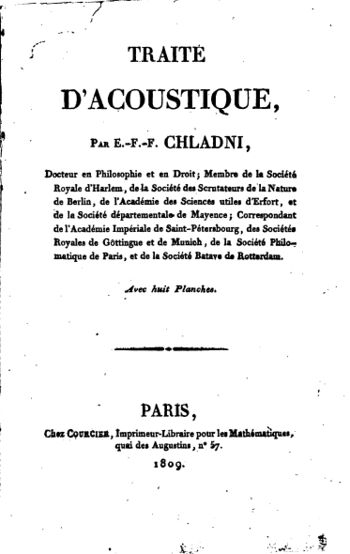
Works by Chladni on acoustics[edit]
- Entdeckungen über die Theorie des Klanges [Discoveries in the Theory of Sound], Leipzig, 1787, 78 pp. Reprint, Leipzig, 1980. (German) [60]
- "Von dem Euphon, einem neuerfundenen musikalischen Instrumente", Journal von und für Deutschland, Vol. 7, No. 1 (1790), pp 201-202. (German)
- "Geschichte der Erfindung des Euphons und einiger anderer akustischer Entdeckungen", Magazin für das Neueste aus der Physik und Naturgeschichte, Vol. 9, No. 4 (1794), pp 100-116. (German)
- "Nachricht von dem gedanken des Hrn. D. Chladni über den Ursprung der von Pallas gefundenen und anderer ihr ähnliche, Eisenmassen nebst einigen damit in Verbindung stehenden Naturerscheinugen", Magazin für das Neueste aus der Physik und Naturgeschichte, Vol. 9, No. 4 (1794), pp 116-129. (German)
- "Beyträge zur Beförderung eines bessern Vortrages der Klanglehre", Der Gesellschaft naturforschender Freunde zu Berlin, Neue Schriften, Vol. 1 (1795), pp 102-124. (German)
- "Beobachtungen über die durch Brennen der entzündbaren Luft in einer Röhre hervorzubringenden Töne", Der Gesellschaft naturforschender Freunde zu Berlin, Neue Schriften, Vol. 1 (1795), pp 125-130. (German)
- Űber die Longitudinalschwingungen der Saiten und Stäbe, Erfurt: G. A. Keyser, 1796, 14 pp. (German) [61]
- "Über drehende Schwingungen eines Stabes", Der Gesellschaft naturforschender Freunde zu Berlin, Neue Schriften, Vol. 2 (1799), pp 274-277. (German)
- Die Akustik, Leipzig: Breitkopf & Härtel, 1802, 310 pp. Second edition, 1830. (German) [62]
- Traité d'acoustique, Paris: Chez Courcier, 1809. A biographical preface added. Second edition, 1812. (French) [63] [64]
- Neue Beyträge zur Akustik, Leipzig: Breitkopf und Härtel, 1817. Reprint, Leipzig, 1980. (German) [65] [66]
- Beiträge zur praktischen Akustik und zur Lehre vom Instrumentenbau, enthaltend die Theorie und Anwendung zum Bau des Clavicylinders und verwandter Instrumente, Leipzig, 1821. Reprint, Leipzig, 1980. (German)
- "E. F. F. Chladni, über sein neues Euphon, und über die Gesetze, nach welchen sich die Schwingungen in demselben richten", Annalen der Physik, Vol. 75, No. 9 (1823), pp 69–82. (German)
- "Über die Hervorbringung der menschlichen Sprachlaute", Annalen der Physik, Leipzig, 1824. (German)
- "Űber eine verunstaltete Nachricht von der bekannten Wetterharfe zu Basel", Annalen der Physik, Leipzig, 1825, pp 471–473. (German) Excerpt.
- "Über meine Aufnahme bei Napoleon und sonst in Paris", Cäcilia, 5 (1826), pp 137-144. (German)
- Kurze Übersicht der Schall- und Klanglehre, nebst einem Anhange die Entwickelung und Anordnung der Tonverhältnisse betreffend, Mainz, 1827. (German)
- "Autobiographie" (used as Necrologue), Cäcilia, 6 (1827), pp 297-308. (German)
Works by Chladni on meteoritics[edit]
- Über den Ursprung der von Pallas gefundenen und anderer ihr ähnlicher Eisenmassen und über einige damit in Verbindung stehende Naturerscheinungen [On the Origin of the Pallas Iron and Others Similar to it, and on Some Associated Natural Phenomena], Leipzig and Riga, 1794. (German)
- Reprinted as Über den kosmischen Ursprung der Meteorite und Feuerkugeln (1794), with commentary by Gimter Hoppe, Leipzig: Ostwalds Klassiker der exakten Wissenschaften, 1979. (German)
- Über Feuermeteore und die mit denselben herabgefallenen Massen, Vienna: J. G. Heubner, 1820. (German) [67] [68] [69]
Monographs on Chladni[edit]
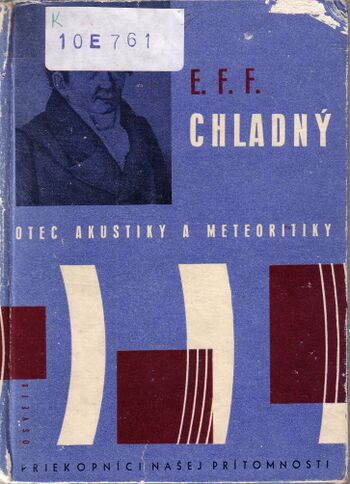
- Wilhelm Bernhardt, Dr. Ernst Chladni, der Akustiker. Eine Biographie und geschichtliche Darstellung seiner Entdeckungen zur Erinnerung an seinen hundertjährigen Geburtstag den 30. November 1856, Wittenberg: Franz Mohr, 1856. (German)
- Melde, Franz (1866). Ueber Chladni's Leben und Wirken: nebst einem chronologischen Verzeichnis seiner literärischen Arbeiten. Marburg: C. L. Pfeil. pp. 51 (German). 2nd edition, Marburg: N.G. Elwert'sche Verlagsbuchhandlung, 1888, 80 pp.
- Rumanovský, Ivan; Stadtrucker, Ivan (1961). E.F.F. Chladný: Otec akustiky a meteoritiky. Martin: Osveta. pp. 141 (Slovak).
- Dieter Ullmann, Ernst Florens Friedrich Chladni, Leipzig: BSB B. G. Teubner Verlagsgesellschaft, 1983. (German)
- Ullmann, Dieter (1996). Chladni und die Entwicklung der Akustik von 1750-1860. Basel: Birkhäuser. pp. 237. ISBN 3-7643-5398-8 (German).
Book chapters, Papers and Articles on Chladni[edit]
- "On the invention of the euphon, and other acoustic discoveries of C. F. F. Chladni", Philosophical Magazine Series 1, Vol. 2, No. 8 (1799), pp 391-398. [70]
- Goethe, Johann Wolfgang (1817). "Schicksal der Handschrift". Zur Morphologie.
- Wilhelm Weber, "Lebensbild E. F. F. Chladnis", in Allgemeine Enzyklopädie der Wissenschaften und Künste, Vol. 21, edited by J. S. Ersch and J. G. Gruber, Leipzig, 1830. Reprinted in: Wilhelm Weber, Werke, Vol. 1: Akustik, Mechanik, Optik und Wärmelehre Berlin, 1892. (German)
- Steffens, Henrich (1844). "Die letzten". Was ich erlebte: aus der Erinnerung niedergeschrieben, Vol. IX. Breslau: Josef Max. pp. 275–368 (German).
- Eugen von Lommel, "Chladni, Ernst Florenz Friedrich", Allgemeine Deutsche Biographie, Bd. 4, Leipzig: Duncker & Humblot, 1876, pp 124–126.
- Marie-Nicolas Bouillet, Alexis Chassang (eds.), "Ernst Chladni", in Dictionnaire universel d’histoire et de géographie, 1878. (French)
- Erich Ebstein, "Aus Chladnis Leben und Wirken", Mitteilungen zur Geschichte der Medizin und der Naturwissenschaften, 4 (1905), pp 438-460. (German)
- K. Locwenfeld, "E. F. F. Chladni. Skizze von Leben und Werk", Abhandlungen aus dem Gebiet der Naturwissenschaften, 22 (1929), Naturwiss. Verein Hamburg, pp 117-144. (German)
- R. Földes, "Chladni", Výročná správa Československej reálky, Košice, 1931. (Slovak)
- R. Földes, "Chladni. Otec akustiky", Časopis pro pěstování matematiky a fysiky, No. 8, 1931, p 9. (Slovak)
- Hans Schimank, "Beiträge Zur Lebensgeschichte von E. F. F. Chladni", Sudhoffs Archiv für die Geschichte der Medizin und der Naturwissenschaften, 37 (1953) pp 370-376. (German)
- Hans Schimank, "Chladni, Ernst Florenz Friedrich", Neue Deutsche Biographie, Bd. 3, Berlin: Duncker & Humblot, 1957, p 205. [71] (German)
- Günter Hoppe, "Das Pallas-Eisen, ein Ausgangspunkt fÜr die Meteoritenrheorie E. F. F. Chladnis (1794)", Zeitschrift fur geologische Wissenschaften, 4 (1976), Berlin, pp 521-528. (German)
- Günter Hoppe, "Ernst Florens Friedrich Chladni. Zum 150. Todestag des Begründers der Meteoritenkunde", Chemie der Erde, 36 (1977), pp 249-262. (German)
- Günter Hoppe, "Goethes Ansichten über Meteorite und sein Verhältnis zu dem Physiker Chladni", Goethe-Jahrbuch, 95 (1978) pp 227-240. (German)
- T. D. Rossing, "Chladni's Law for Vibrating Plates", American Journal of Physics 50 (1982), pp 271–274.
- Dieter Ullmann, "Chladnis Italienreise nach Briefen von J.P. Schulthesius", NTM-Schriftenreihe fur Geschichte der Naturwissenschaften, Technik und Medizin, Vol. 2, No. 19 (1982), Leipzig, pp 51-57. Correction ibid. No. 20 (1983), p 89. (German)
- Dieter Ullmann, "Chladni und die Entwicklung der experimentellen Akustik um 1800", Archive History Exact Sci. 31 (1984), pp 35-52. (German)
- Walther Killy (ed.), Literaturlexikon: Autoren und Werke deutscher Sprache, Bd. 2, 1988 p 408. (German)
- Dieter Ullmann, "Chladni und Ottmer - ein frühes Beispiel für die Zusammenarbeit von Akustiker und Architekt", Acustica 71, H.1 (1990), pp 58-63. (German)
- U.B. Marvin, "Ernst Florenz Friedrich Chladni (1756-1827) and the origins of modern meteorite research", Meteoritics & Planetary Science, 31 (1996), pp 545-588.
- "Ernst Florens Friedrich Chladni (1756–1827) and the origins of modern meteorite research". Meteoritics 31 (5): 545–588. 1996.
- Dieter Ullmann, "Chladnis Beiträge zur Raumakustik", NTM International Journal of History & Ethics of Natural Sciences, Technology & Medicine, Vol. 14, No. 1 (Feb 2006), pp 1-8. (German)
- Myles W. Jackson, Harmonious Triads: Physicists, Musicians, and Instrument Makers in Nineteenth-Century Germany, MIT Press, 2006.
- Mešterová, Jana (2006). "Ernest Florens Fridrich Chladný – Chladni: Fyzik so slovenskými koreňmi, nazývaný otec akustiky a meteoritiky". XXIII. Zborník dejín fyziky. Bratislava: Slovenská spoločnosť pre dejiny vied a techniky pri SAV. pp. 127–132 (Slovak).
- Heise, B. (6 2007). "Chladni's clavicylinder and some imitations". The European Physical Journal Special Topics 145 (1): 3–14.
- Stöckmann, Hans-Jürgen (6 2007). "Chladni meets Napoleon". The European Physical Journal Special Topics 145 (1): 15–23. German version, 2006.
- Ullmann, Dieter (6 2007). "Life and work of E.F.F. Chladni". The European Physical Journal Special Topics 145 (1): 25–32.
- J. Biała, "Ernst Florens Friedrich Chladni — ojciec akustyki i meteorytyki", Mat. V Konf. Meteorytowej, Wrocław, 2008. (Polish)
- W. Czajka, "Cmentarz Wielki we Wrocławiu - miejsce pochówku E.F.F. Chladniego", Mat. V Konf. Meteorytowej, Wrocław, 2008. (Polish)
- A. Dobrucki, "Ernst Chladni i początki nowoczesnej akustyki", Mat. V Konf. Meteorytowej, Wrocław, 2008. (Polish)
- Marian Stępniewski, Hubert Sylwestrzak, "Ernst Florens Friedrich Chladni (1756–1827) — ojciec meteorytyki", Przegląd Geologiczny, 3 (2008). (Polish)
- more
On Chladni figures[edit]
- Ritter, Johann Wilhelm (1810). Fragmente aus dem Nachlasse eines jungen Physikers: Ein Taschenbuch fuer Freunde der Natur. 2. Heidelberg: Mohr und Zimmer.
- Germain, Sophie (1821). Recherches sur la théorie des surfaces élastiques. Paris: M.V. Courcier.
- Ernst Heinrich Weber, Wilhelm Weber, Wellenlehre auf Experimente gegründet oder über die Wellen tropfbarer Flüssigkeiten mit Anwendung auf die Schall- und Lichtwellen, Leipzig: Gerhard Fleischer, 1825. (German) [72]
- Wheatstone, Charles (1833). "On the Figures Obtained by Strewing Sand on Vibrating Surfaces, Commonly Called Acoustic Figures". Philosophical Transactions of the Royal Society of London (The Royal Society) 123: 593–633.
- Higgins, W. Mullinger (1838). The Philosophy of Sound, and History of Music. London: Wm. S. Orr.
- Kirchhoff, G. (1850). "Über das Gleichgewicht und die Bewegung einer elastischen Scheibe". Journal für die reine und angewandte Mathematik 1850 (50): 51–88 (German).
- Franz Josef Pisko, "Tönende Platten", in Die neueren Apparate der Akustik. Für Freunde der Naturwissenschaft und der Tonkunst, Vienna: Carl Gerold's Sohn, 1865, pp 156-169. (German)
- Voigt, W. (1893). "Bemerkung zu dem Problem der transversalen Schwingungen rechteckiger Platten". Göttingen Nachrichten (Königl. Gesellschaft der Wissenschaften und der Georg-Augusts-Universität): 225–230 (German).
- Strutt (Baron Rayleigh), J. W. (1894). The Theory of Sound, Vol. I (2 ed.). London: Macmillan.
- Ritz, Walter (1909). "Theorie der Transversalschwingungen einer quadratischen Platte mit freien Rändern". Annalen der Physik 333 (4): 737–786 (German).
- Adorno, Theodor W. (15 December 1934). "Die Form der Schallplatte". 23: Eine Wiener Musikzeitschrift (17-19): 35–39 (German).
- Adorno, Theodor W. (1990). "The Form of the Phonograph Record". October (The MIT Press) 55 (Winter): 56–61.
- Theodor W. Adorno, Klangfiguren: Musikalische Schriften I, Frankfurt a.M.: Suhrkamp Verlag, 1959. Republished in Gesammelte Schriften, Vol. 16. (German)
- Mary Desiree Waller, Chladni Figures: A Study in Symmetry, London: G. Bell, 1961.
- Benjamin, Walter (1998). The Origin of the German Tragic Drama. Translated by John Osborne. London/New York: Verso. Originally published in German as Unsprung des deutschen Trauerspiels, 1963.
- Levin, Thomas Y. (1990). "For the Record: Adorno on Music in the Age of Its Technological Reproducibility". October (The MIT Press) 55 (Winter): 23–47.
- James F. Bell, "The late-twentieth century resolution of a mid-nineteenth century dilemma generated by the eighteenth-century experiments of Ernst Chladni on the dynamics of rods", Archive for History of Exact Sciences, Vol. 43, No. 3 (1991), pp 251-273.
- Hankins, Thomas Leroy; Silverman, Robert J. (1995). Instruments and the Imagination. Princeton University Press. pp. 337.
- Jenny, Hans (2001). Cymatics: A Study of Wave Phenomena and Vibration.
- Jackson, Myles W. (2006). "E. F. F. Chladni: The Nodal Point between Acoustician and Musical-Instrument Maker". Harmonious Triads: Physicists, Musicians, and Instrument Makers in Nineteenth-Century Germany. Cambridge, MA: The MIT Press. pp. 13–44.
- Miroslav Tibor Morovics, "Chladniho obrazce v Antolikovom podaní", in XXIII. Zborník dejín fyziky, Bratislava: Slovenská spoločnosť pre dejiny vied a techniky pri SAV, 2006, pp 133–140. (Slovak)
- Courtial, J.; O'Holleran, K. (6 2007). "Experiments with twisted light". The European Physical Journal Special Topics 145 (1): 35–47.
- Gough, Colin (6 2007). "The violin: Chladni patterns, plates, shells and sounds". The European Physical Journal Special Topics 145 (1): 77–101.
- Brüning, J. (6 2007). "Nodal sets in mathematical physics". The European Physical Journal Special Topics 145 (1): 181–189.
- Gnutzmann, S.; Karageorge, P.; Smilansky, U. (6 2007). "A trace formula for the nodal count sequence". The European Physical Journal Special Topics 145 (1): 217–229.
- Libisch, F.; Rotter, S.; Burgdörfer, J. (6 2007). "Chladni figures in Andreev billiards". The European Physical Journal Special Topics 145 (1): 245–254.
- Szendy, Peter (2008). "Klangfiguren (a hit in the lab)". In Kursell, Julia. Sounds of Science – Schall im Labor (1800–1930). Max Planck Institute for the History of Science. pp. 21–27.
- Gander, Martin J.; Wanner, Gerhard (2012). "From Euler, Ritz, and Galerkin to Modern Computing". SIAM Review (Society for Industrial and Applied Mathematics) 54 (4).
